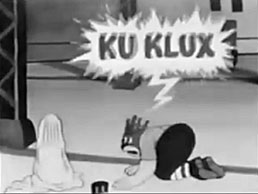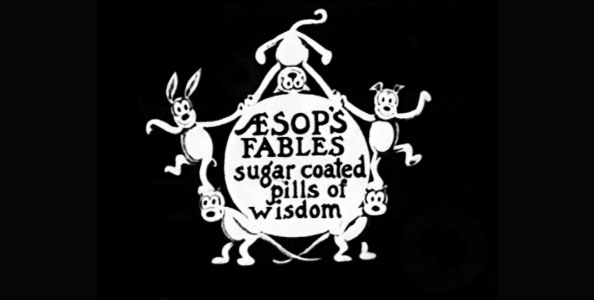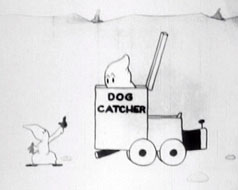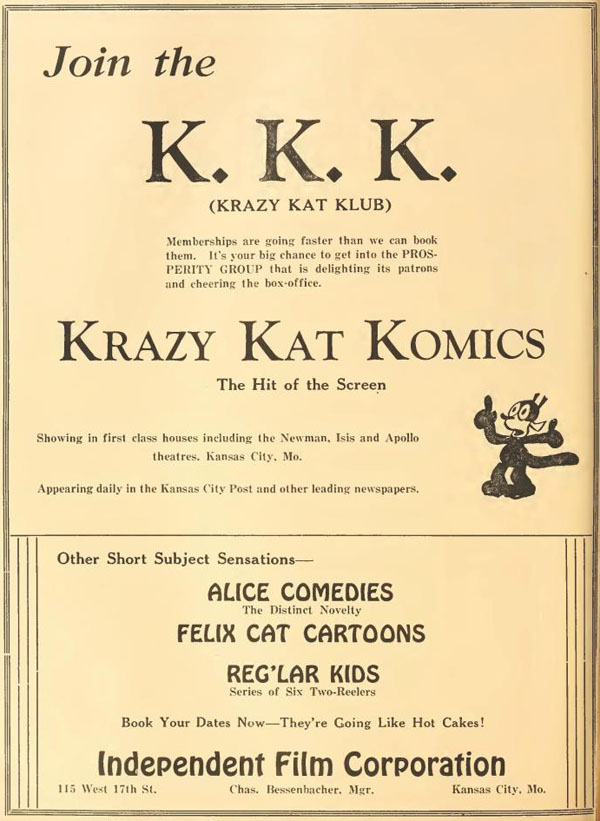
From the Mutt and Jeff cartoon “Accidents Won’t Happen” (1925)
In addition, Bud Fisher, who produced the “Mutt and Jeff” cartoon series, advised animators to avoid caricatures that could offend African Americans. “For while using the negro as a butt for comedy might be popular in New England, in the South where the exhibitor is largely dependent on colored patronage, it would be very unwise,” he told Motography magazine for its August 25, 1917 issue.

One of the very few animated films to caricature the Klan at the height of the revival’s popularity was the “Aesop’s Fables” episode The Wayward Dog, which the Keith-Albee company released ninety-five years ago this month. The film’s plot is about a dog who falls in with a lawless pack and then breaks the law himself. The print advertisement for the cartoon does not hint at content concerning the organization; instead, it contains a sketch by Paul Terry of a canine officer holding a dog. The fable’s “moral” below the sketch read as follows:
A wayward pup once joined a crew
Of dogs who stole and burgled, too.
One night, when they set out to rob,
They made him lookout on the job.
Some people came—he barked, and they
(the robber-dogs) all got away;
Only the wayward pup was caught,
From which we gain this Moral Thought
This maxim, full of wisdom deep:
“We’re judged by company we keep!”

Images evoking the Klan from Disney’s “Alice’s Mysterious Mystery” (1926)

From “Alice’s Mysterious Mystery” (1926)
Commercial animation rarely addressed political movements after The Wayward Dog. Some studio cartoons referred to the Prohibition Era, unionism, and the counterculture over the next four decades. However, animators opted to entertain without advocacy after the 1920s. As the animators became less “ethnic” and more mainstream, and their films evolved in the film industry from novelties to essential Hollywood film-packaging, the immigrants and children of immigrants had less incentive to use their art for protest.

Meanwhile, cartoon marketers played upon the familiarity of the “KKK” initials when publicizing animating films. Initially, newspapers promoted Silent-Era “Krazy Kat” episodes as “Krazy Kat Komedies” and then “Krazy Kat Kartoons.” Columbia Pictures later marketed the character’s Saturday matinees as the Krazy Kat Klub (above). From the 1930s to the 1960s, theaters nationwide promoted their cartoon matinees as “Kiddie Kartoon Karnivals” and, after Technicolor’s development, “Kolor Kartoon Karnivals.” Also, in 1947 the Interstate theater chain from Dallas packaged cartoons together and released the compilation as Mirth of a Nation, in reference to the 1915 pro-Klan movie Birth of a Nation. Nevertheless, the gravitation of publicists to the acronym did not extend to the studios, and the Aesop’s Fables studio set the animation industry’s precedent for standing against the Ku Klux Klan.


 Christopher P. Lehman is a professor of ethnic studies at St. Cloud State University in St. Cloud, Minnesota. His books include American Animated Cartoons of the Vietnam Era and The Colored Cartoon, and he has been a visiting fellow at Harvard University.
Christopher P. Lehman is a professor of ethnic studies at St. Cloud State University in St. Cloud, Minnesota. His books include American Animated Cartoons of the Vietnam Era and The Colored Cartoon, and he has been a visiting fellow at Harvard University.



























!!!!!!!
This is fascinating stuff. Imagine what the industry would have been like if there were the occasional political satire as animated cartoon in theaters. Despite toon matinees being considered “kiddie” fare, I still attest to classic theatrical cartoons being for all ages. It seemed to me that, at the dawn of TV animation, there emerged a more kid-friendly fare, like Art Clokey’s GUMBY which, despite the occasional reflection of entertainment of the times (Western “legends” and all that) had a more magical and gentle nature than most other animation studios.
Jay Ward was as close to political/social satire as animation would get, and I enjoy the cartoons for that reason, but there is also something to be said for the first wave of “kids’ cartoons” as the stories were well written and could even keep an adult interested, but you could also feel this impression that the audience to some animated fare was to be strictly kids. This could be in part because some folks felt that the theatrical cartoons being aired during children’s hours were so much harsher than they remembered them. I think kids enjoyed them anyway, even if we didn’t get the references. I wonder, though, how many animators of the golden age might have been secretly chomping at the bitt to be “political” or socially relevant. Great post!
It’s weird to think such a concept was rather foreign to the mainstream for along time back then. It really wasn’t until the “underground” movement when that stuff started to show up among the public in certain places.
They probably wished they have had a head-start before it already happened.
That animated cartoons did not take off on the Ku Klux Klan more often was actually part of a larger trend in show business. Songs such as Billy Fritsch’s “Ku Ku (The Klucking of the Ku Klux Klan)” were the exception, rather than the rule.
Even Will Rogers held to that standard when, at the end of his Victor recording “Timely Topics” commented.
“I hear the Ku Klux is in town agaon. . . NO SIR–I AIN’T MAKING ANY JOKES ABOUT THEM!”
This makes Cliff Edwards’ record of “Insufficient Sweetie” all the more curious, as it contains the following.
“Now you may think that you will hold my hand
That’s when a rabbi’ll be the Kleagle of the Ku Klux Klan!”
As for cartoons getting “less ethnic”,I’d have to quote Mr. Peavey, the druggist from “The Great Gildersleve””
“Well, now–I wouldn’t say that!”
If that were the case, how do you explain the appearance of the Hebrew characters for “Kosher for Passover” in such cartoons as “I’ll Be Glad When You’re Dead, You Rascal You” (1933, Fleischer)–or the Warner Bros.cartoon in which one squirrel is identifying his hoard of nuts as being “kosher for Passover’?
I never said the cartoons became less “ethnic” but rather that the animators did, and I had Isadore Freleng’s rechristening as “I. Freleng” in mind when I wrote that. You are correct that the Fleischer Studio incorporated immigrant ethnic humor into its work well into the sound era. My point was that ethnicity did not become a rallying cry for animators after cartoons from the 1920s like “The Wayward Dog.” The decline of the KKK to rally against may have been one reason, but the ability of immigrants and 2nd-generation folks to adapt to anti-Semitism and other anti-immigrant hostilities may have been another.
That part of history is rather fascinating to me. I’m sure it all really build up inside every one of them into the 50’s and 60’s. This sort of bottled-up approach as I put it.
The Klan’s influence outside of its normal southern roots was probably at its highest in the 1920s, particularly around the election of 1928, when Al Smith became the first Catholic to run for president. Klan activities in the areas surrounding New York City were not uncommon, and given how many studios were still NY-based at the time and (as noted) how many people working for those studios would be KKK targets, it’s no shock they didn’t see it as a laughing matter.
I wonder if the ability to not give in was a coping mechanism that managed to make it all work without sabotage in the end? It’s always interesting to view history from an anthropological view.
“The Mirth of a Nation” was also a slogan used by MLJ Publishing in the earliest issues of Archie Comics.
Very interesting post, Christopher.
Where might the masked/hooded “wanna be a member” figures in Fleischer’s BIMBO’S INITIATION fit into all this?
I’m pretty sure Bimbo’s Initiation was specifically about the Illuminati and Fremasonry stuff rather than KKK. That cartoon remains awesomely creepy to this day.
I have no idea. The characters do not strike me as Klan-inspired, and I have not found any press coverage that connects the film’s imagery to the Klan. Then again, the organization would have been well past its first-revival peak by 1931, when BIMBO’S INITIATION was released.
There’s nothing wrong with Freemasons!
On a side note, thinking of the ending to The Wayward Dog, it does strike me kinda odd how much it paralleled the sort of anti-capitalist films coming out of the Soviet Bloc years later. It’s never an entire group if they bother to set an example by killing off the one character who contributed little to the situation.
Animators didn’t produce pro-Klan propaganda because so many animators were first of second generation Americans? Likelier animators didn’t produce pro-Klan propaganda because few Klansmen had the money or the talent to go into animation!
This really takes me back. I was eight years old in 1993 and loved classic cartoons, so this was right up my alley.